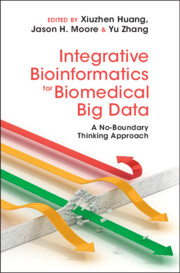Book contents
- Integrative Bioinformatics for Biomedical Big Data
- Integrative Bioinformatics for Biomedical Big Data
- Copyright page
- Dedication
- Contents
- Contributors
- 1 No-Boundary Thinking
- 2 Artificial Intelligence Approaches to No-Boundary Thinking
- 3 No-Boundary Thinking in Undergraduate Bioinformatics Education
- 4 No-Boundary Course Developments
- 5 No-Boundary Thinking for Transcriptomics and Proteomics Big Data
- 6 Pharmacogenomics
- 7 The Ethical Status of an AI
- 8 Computational Thinking and No-Boundary Thinking
- 9 Carving Nature at the Joints: Which Joints?
- Index
- References
4 - No-Boundary Course Developments
Published online by Cambridge University Press: 14 September 2023
- Integrative Bioinformatics for Biomedical Big Data
- Integrative Bioinformatics for Biomedical Big Data
- Copyright page
- Dedication
- Contents
- Contributors
- 1 No-Boundary Thinking
- 2 Artificial Intelligence Approaches to No-Boundary Thinking
- 3 No-Boundary Thinking in Undergraduate Bioinformatics Education
- 4 No-Boundary Course Developments
- 5 No-Boundary Thinking for Transcriptomics and Proteomics Big Data
- 6 Pharmacogenomics
- 7 The Ethical Status of an AI
- 8 Computational Thinking and No-Boundary Thinking
- 9 Carving Nature at the Joints: Which Joints?
- Index
- References
Summary
The rise of interdisciplinary and no-boundary engagement has created a need to train the next generation of No-Boundary Thinking (NBT) scholars and practitioners. So it is essential that students be provided with NBT experiences in the classroom and through group-based research experiences. Our no-boundary community has offered a first generation of classes to provide an environment where students can engage in no-boundary projects and exercises, and reflect upon the nature of this type of thinking and problem solving. The following five classes were first offered in fall 2015 through spring 2018 at four institutions for undergraduate and graduate students. The experience has been enriching for both students and faculty. In all cases the courses have been well received by the students and institutions, and most instructors plan to continue to provide the classes as permanent offerings. We describe the early offerings of each class.
Keywords
- Type
- Chapter
- Information
- Integrative Bioinformatics for Biomedical Big DataA No-Boundary Thinking Approach, pp. 45 - 66Publisher: Cambridge University PressPrint publication year: 2023

